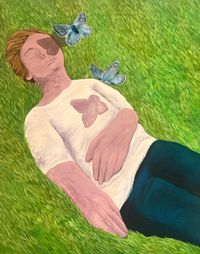
For her third solo exhibition with Galerie Dumonteil entitled Les Mondes flottants, Tess Dumon presents a series of seven gouache on canvas artworks freshly painted in her Parisian studio. Trained as a sculptor and visual artist, this is the first time the artist has shown an exhibition composed exclusively of paintings. The title of this new presentation, Floating Worlds (from the Japanese word Ukyo), refers to the impermanence of the material world in the Buddhist tradition and the multiple artistic variations that it inspires Japanese poets and printmakers. The novelist Asai Ryoi was the first to use the term in 1661, when he defined it as 'living only for the moment, contemplating the moon, the snow, the cherry blossoms and the autumn leaves...' Following in Ryoi's footsteps, Tess Dumon invites us through her new works to explore the emotional and poetic richness of ephemeral moments, many of which are drawn from her personal experience.
Tess Dumon's artistic training did not predispose her to painting on canvas, a medium she adopted later on. She graduated with honours from Central Saint Martins and then from the Royal College of Arts, and initially made her mark through sculpture and drawing. However, the large wire mesh structures for which she became known already addressed the themes of her paintings. Many of them depicted horses, in reference to the horse therapy her brother, who was disabled from birth, received. The latter is also omnipresent in Tess Dumon's work of a mysterious young man. In her latest paintings, she again uses the figures of the boy and the horse to symbolise moments of peace and grace in a life hardened by illness. The artist does not hide her brother's disability, which is made evident by the disproportionate size of his hands, which look more like the wings of an angel. This analogy makes it possible to transcribe the ambivalence between this character's inadequacy and his extraordinary sensitivity. We also find in this metaphor the contradiction between heaviness and lightness already conveyed in her sculptures, their supple and translucent aspect contrasting with the hardness of the metal.
In reference to the Japanese Ukyo, Tess Dumon's latest paintings are imbued with a nostalgia, through night landscapes where the milky way rubs shoulders with rivers and trees (If Trees Could Talk), fields (Les Immortelles) and the sea (Midnight Treasure). The ultramarine blue and violet tones that dot the canvases reinforce their ethereal atmosphere and make them appear like fleeting memories. In Midnight Treasure, for example, the boy holds a piece of polished green found on the sand in his hand: the artist invites us to remember our childhood wonders through him. This nostalgia can also take a melancholic turn, as in the painting Wish You Were Here, where it is illustrated from the perspective of loss. Here too, Tess Dumon plays on the contrast between the fleeting memory that has faded too quickly and the eternal beauty.
Dumon draws her inspiration from literature, poetry and art history. She refers to Pierre Bonnard in particular, from whom she learned a great deal about the use of colour. The artist combines these various influences in a subtle way in her paintings, while telling a deeply personal, loving, and poetic story.
— Ugo Scalia and Yoann
Press release courtesy Dumonteil Contemporary.
8 rue d'Aboukir, 75002,
Paris, France